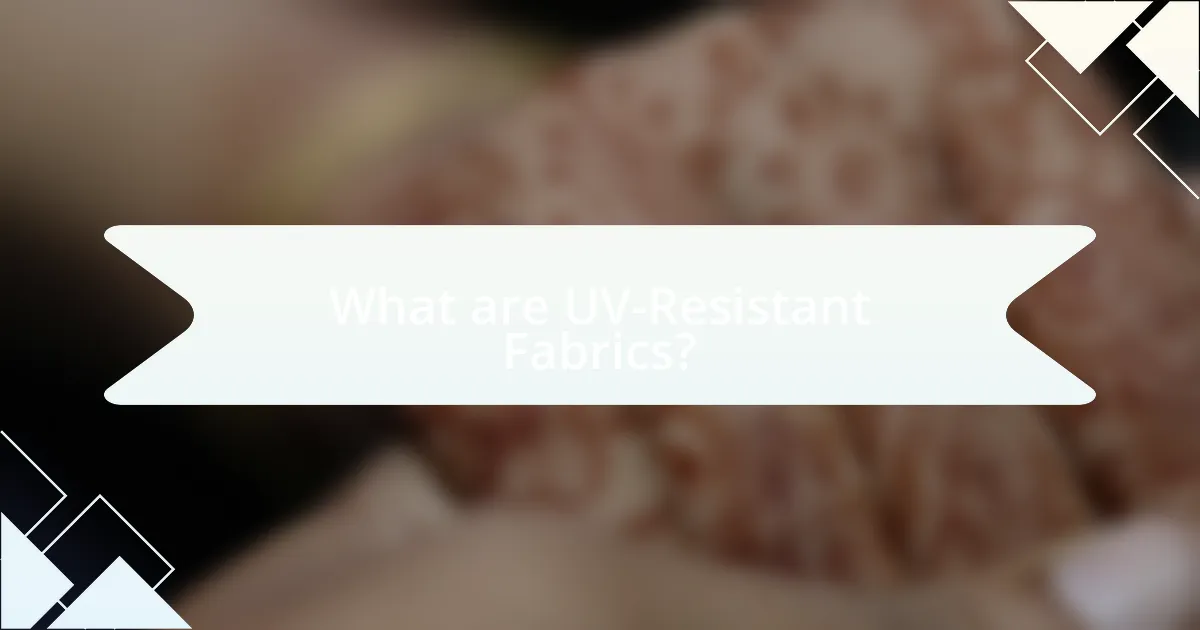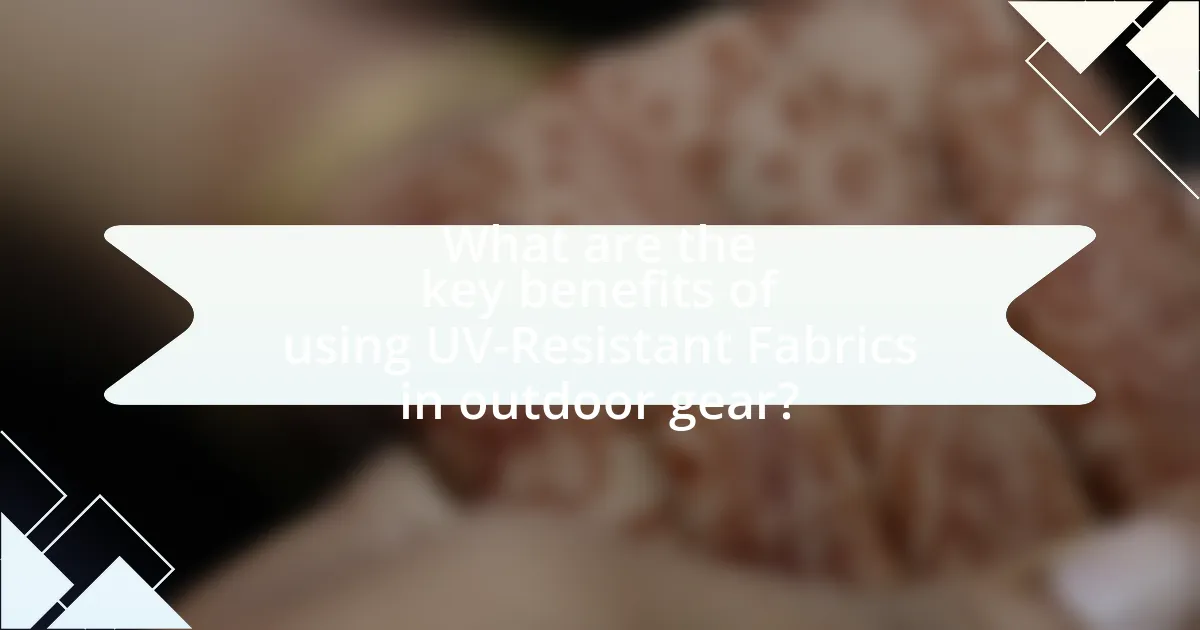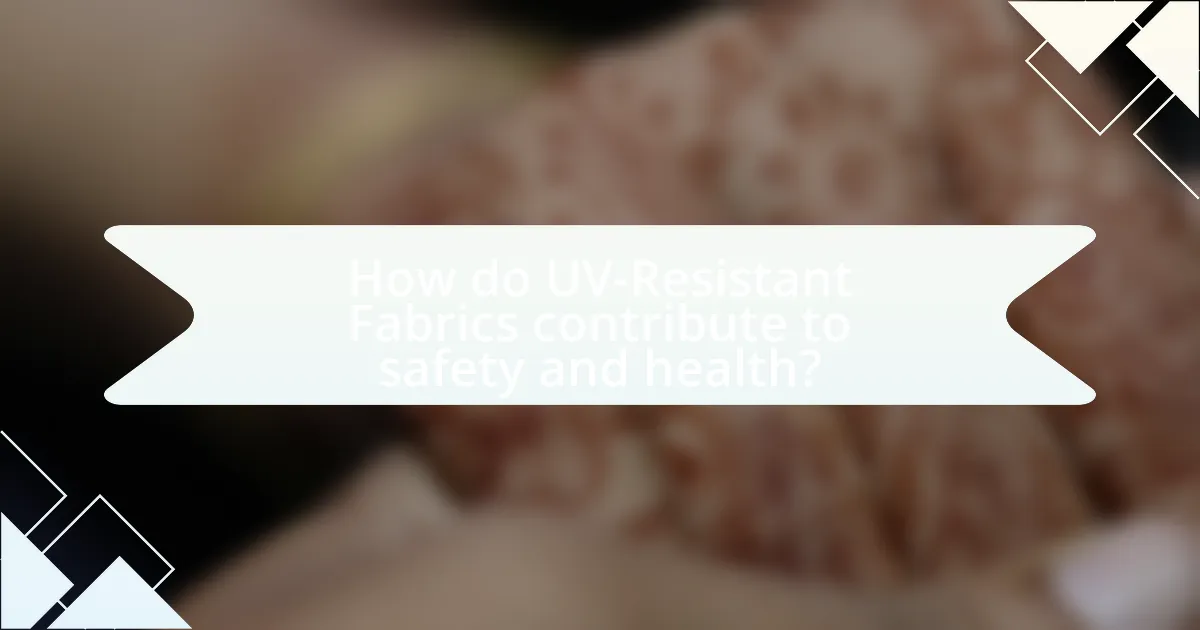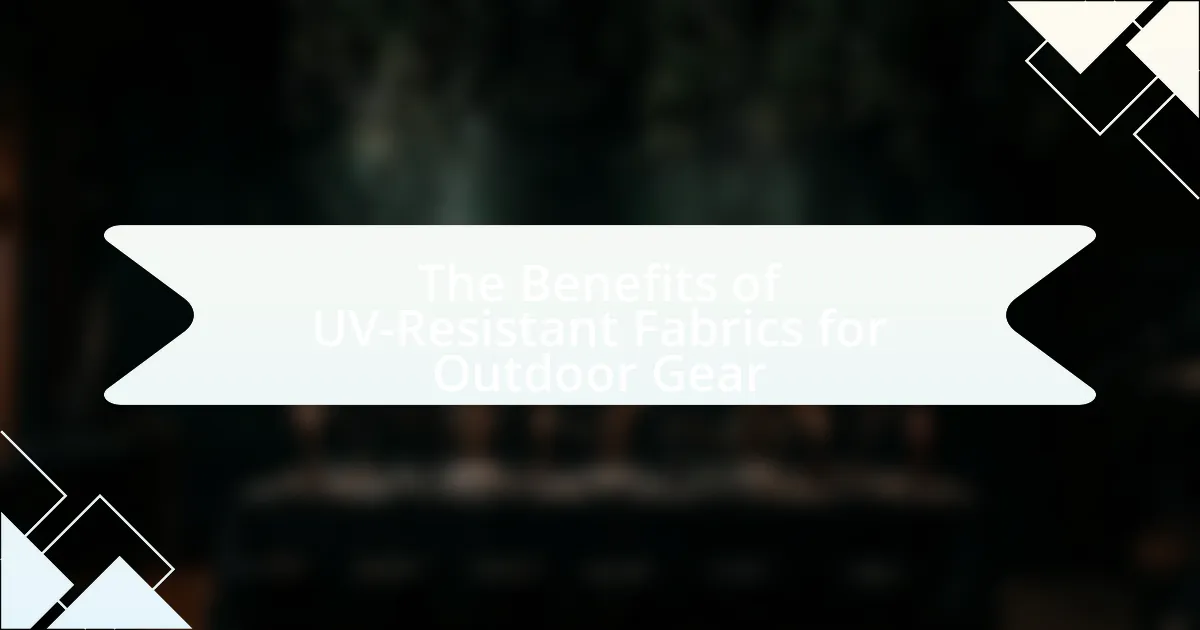UV-resistant fabrics are specialized materials designed to block or absorb harmful ultraviolet (UV) radiation, providing essential protection for outdoor gear and users. These fabrics, often made from polyester, nylon, or acrylic, can block up to 98% of UV rays, significantly reducing the risk of skin damage and fabric degradation. The article explores the differences between UV-resistant and regular fabrics, the materials commonly used, and how UV resistance is measured through the Ultraviolet Protection Factor (UPF) rating system. Additionally, it highlights the importance of UV-resistant fabrics in enhancing the durability and comfort of outdoor gear, as well as their role in promoting health and safety for outdoor enthusiasts. Best practices for maintaining these fabrics and extending their lifespan are also discussed, emphasizing the need for proper care to preserve their protective qualities.

What are UV-Resistant Fabrics?
UV-resistant fabrics are materials specifically designed to block or absorb ultraviolet (UV) radiation, thereby protecting the skin and prolonging the lifespan of the fabric. These fabrics are often treated with special coatings or made from fibers that inherently possess UV-blocking properties, such as polyester or nylon. Research indicates that UV-resistant fabrics can block up to 98% of harmful UV rays, significantly reducing the risk of skin damage and fading of colors in outdoor gear.
How do UV-Resistant Fabrics differ from regular fabrics?
UV-resistant fabrics differ from regular fabrics primarily in their ability to block or absorb ultraviolet (UV) radiation. Regular fabrics typically allow a significant amount of UV rays to penetrate, which can lead to skin damage and fabric degradation over time. In contrast, UV-resistant fabrics are specifically engineered with additives or treatments that enhance their protective qualities, often achieving a UPF (Ultraviolet Protection Factor) rating that indicates their effectiveness against UV exposure. For example, fabrics with a UPF rating of 50 can block approximately 98% of UV rays, significantly reducing the risk of sunburn and long-term skin damage compared to standard materials.
What materials are commonly used in UV-Resistant Fabrics?
Common materials used in UV-resistant fabrics include polyester, nylon, and acrylic. Polyester is favored for its durability and resistance to fading, while nylon offers strength and elasticity, making it suitable for outdoor applications. Acrylic fabrics are also popular due to their excellent UV protection and color retention. These materials are often treated with UV inhibitors to enhance their protective qualities, ensuring they withstand prolonged exposure to sunlight without significant degradation.
How is the UV resistance of fabrics measured?
The UV resistance of fabrics is measured using the ultraviolet protection factor (UPF) rating system. This system quantifies the amount of UV radiation that can penetrate the fabric, with higher UPF values indicating greater protection. For example, a fabric with a UPF of 50 allows only 1/50th of UV radiation to pass through, effectively blocking 98% of harmful rays. Testing is typically conducted in accordance with standards set by organizations such as ASTM International, which provides guidelines for measuring the UV transmission of textiles.
Why are UV-Resistant Fabrics important for outdoor gear?
UV-resistant fabrics are important for outdoor gear because they protect users from harmful ultraviolet radiation. Prolonged exposure to UV rays can lead to skin damage, including sunburn and increased risk of skin cancer. Fabrics treated with UV resistance can block up to 98% of these rays, significantly reducing the risk of skin-related health issues. Additionally, UV-resistant materials enhance the durability of outdoor gear by preventing fabric degradation and fading, which can occur due to sun exposure. This longevity ensures that outdoor gear remains functional and visually appealing over time, making UV resistance a critical feature for anyone engaging in outdoor activities.
What risks do UV rays pose to outdoor enthusiasts?
UV rays pose significant risks to outdoor enthusiasts, primarily including skin damage, eye injury, and an increased risk of skin cancer. Prolonged exposure to ultraviolet radiation can lead to sunburn, premature aging of the skin, and the development of malignant melanoma, which is a serious form of skin cancer. According to the Skin Cancer Foundation, one in five Americans will develop skin cancer in their lifetime, highlighting the importance of protection against UV exposure. Additionally, UV rays can cause cataracts and other eye conditions, emphasizing the need for protective eyewear when engaging in outdoor activities.
How can UV-Resistant Fabrics mitigate these risks?
UV-resistant fabrics mitigate risks associated with sun exposure by blocking harmful ultraviolet rays that can cause skin damage and fabric degradation. These fabrics are engineered with special treatments or fibers that absorb or reflect UV radiation, significantly reducing the risk of sunburn and long-term skin conditions such as skin cancer. Studies indicate that UV-resistant materials can block up to 98% of UV rays, providing a protective barrier for users engaged in outdoor activities. This effectiveness is crucial for outdoor gear, as prolonged exposure to sunlight can weaken fabric integrity, leading to premature wear and tear.

What are the key benefits of using UV-Resistant Fabrics in outdoor gear?
UV-resistant fabrics provide essential protection against harmful ultraviolet rays, significantly reducing the risk of skin damage and sunburn during outdoor activities. These fabrics are engineered to block a substantial percentage of UV radiation, often exceeding 98%, which is crucial for prolonged exposure to sunlight. Additionally, UV-resistant materials enhance the durability of outdoor gear by preventing fabric degradation, fading, and loss of strength caused by UV exposure. This longevity translates to better performance and value over time, making UV-resistant fabrics a smart choice for outdoor enthusiasts.
How do UV-Resistant Fabrics enhance durability?
UV-resistant fabrics enhance durability by preventing degradation caused by ultraviolet (UV) radiation. These fabrics are treated with special additives that absorb or reflect UV rays, significantly reducing the risk of fading, weakening, or breaking down over time. For instance, studies have shown that materials like polyester and nylon, when treated for UV resistance, can maintain their structural integrity and color for longer periods compared to untreated fabrics. This increased longevity is crucial for outdoor gear, which is often exposed to harsh sunlight, ensuring that the gear remains functional and visually appealing over extended use.
What role does UV resistance play in fabric longevity?
UV resistance significantly enhances fabric longevity by preventing degradation caused by ultraviolet radiation. Fabrics exposed to sunlight can suffer from fading, weakening, and structural damage over time due to UV rays. For instance, studies have shown that UV-resistant materials can last up to five times longer than non-resistant fabrics when subjected to prolonged sun exposure. This increased durability is crucial for outdoor gear, as it ensures that items like tents, awnings, and clothing maintain their integrity and appearance, ultimately providing better value and performance for users.
How do these fabrics withstand harsh weather conditions?
UV-resistant fabrics withstand harsh weather conditions by utilizing specialized coatings and fibers that repel water, resist fading, and provide UV protection. These fabrics are often made from synthetic materials like polyester or nylon, which are inherently durable and resistant to environmental stressors. For instance, UV-resistant treatments can block up to 98% of harmful UV rays, significantly reducing the risk of degradation from sun exposure. Additionally, many of these fabrics are engineered to be water-resistant or waterproof, ensuring they remain functional and maintain their integrity even in heavy rain or snow. This combination of properties allows UV-resistant fabrics to perform effectively in extreme weather, making them ideal for outdoor gear.
What comfort advantages do UV-Resistant Fabrics provide?
UV-resistant fabrics provide significant comfort advantages by reducing heat buildup and preventing skin irritation during prolonged sun exposure. These fabrics are designed to reflect harmful UV rays, which helps maintain a cooler temperature against the skin, enhancing overall comfort in hot weather. Additionally, UV-resistant materials often possess moisture-wicking properties, allowing sweat to evaporate quickly, further contributing to a comfortable experience. Studies indicate that fabrics with a UPF (Ultraviolet Protection Factor) rating can block up to 98% of UV radiation, thereby minimizing the risk of sunburn and skin damage, which can lead to discomfort.
How do these fabrics affect breathability and moisture-wicking?
UV-resistant fabrics enhance breathability and moisture-wicking by utilizing specialized fibers and weaves that allow air circulation while effectively drawing moisture away from the skin. For instance, polyester and nylon blends are commonly used in outdoor gear due to their lightweight nature and ability to dry quickly, which promotes evaporation of sweat. Studies have shown that fabrics designed with moisture-wicking technology can reduce skin temperature and improve comfort during physical activities, making them ideal for outdoor use.
What impact do UV-Resistant Fabrics have on temperature regulation?
UV-resistant fabrics significantly enhance temperature regulation by reflecting harmful UV rays and reducing heat absorption. This reflective property helps maintain a cooler surface temperature, which is particularly beneficial in outdoor environments where sunlight exposure is high. Studies have shown that fabrics treated with UV-resistant technology can lower the temperature of the material by up to 15 degrees Fahrenheit compared to untreated fabrics, thereby improving comfort for users.

How do UV-Resistant Fabrics contribute to safety and health?
UV-resistant fabrics enhance safety and health by providing protection against harmful ultraviolet (UV) radiation. These fabrics are designed to block a significant percentage of UV rays, reducing the risk of skin damage, including sunburn and long-term effects such as skin cancer. For instance, studies indicate that UV-resistant materials can block up to 98% of UV radiation, significantly lowering exposure during outdoor activities. This protective quality is crucial for individuals who spend extended periods outdoors, as it helps mitigate health risks associated with UV exposure, thereby promoting overall well-being.
What health benefits do UV-Resistant Fabrics offer to users?
UV-resistant fabrics provide significant health benefits by protecting users from harmful ultraviolet (UV) radiation. These fabrics are designed to block a substantial percentage of UV rays, reducing the risk of skin damage, including sunburn and long-term effects such as skin cancer. According to the Skin Cancer Foundation, wearing UV-protective clothing can reduce the risk of developing skin cancer by providing an additional layer of defense against UV exposure. Furthermore, UV-resistant fabrics help prevent premature skin aging and other UV-related skin conditions, contributing to overall skin health.
How do these fabrics help prevent skin damage?
UV-resistant fabrics help prevent skin damage by blocking harmful ultraviolet (UV) radiation from the sun. These fabrics are engineered with specific materials and treatments that absorb or reflect UV rays, significantly reducing the amount of radiation that reaches the skin. For instance, studies have shown that fabrics with a UPF (Ultraviolet Protection Factor) rating of 30 or higher can block up to 97% of UV radiation, thereby minimizing the risk of sunburn and long-term skin damage such as premature aging and skin cancer.
What are the implications for long-term outdoor exposure?
Long-term outdoor exposure can lead to significant health risks, primarily due to increased ultraviolet (UV) radiation exposure. Prolonged UV exposure is linked to skin damage, including sunburn, premature aging, and a heightened risk of skin cancer, with the World Health Organization estimating that 90% of non-melanoma skin cancers are associated with UV exposure. Additionally, long-term exposure can result in eye damage, such as cataracts, as UV rays can penetrate the eye and affect its internal structures. Therefore, utilizing UV-resistant fabrics in outdoor gear is crucial for mitigating these health risks, as these materials can effectively block harmful UV rays, providing essential protection for individuals engaged in prolonged outdoor activities.
How do UV-Resistant Fabrics influence outdoor gear design?
UV-resistant fabrics significantly influence outdoor gear design by enhancing durability and protection against harmful ultraviolet radiation. These fabrics are engineered to absorb or reflect UV rays, which helps prevent skin damage and fabric degradation. For instance, outdoor gear made from UV-resistant materials can maintain structural integrity and color vibrancy over extended periods of sun exposure, thereby increasing the lifespan of the product. Research indicates that fabrics with a UPF (Ultraviolet Protection Factor) rating of 30 or higher can block up to 97% of UV radiation, making them essential for outdoor apparel and gear. This integration of UV protection into design not only meets consumer demand for safety but also aligns with industry standards for outdoor equipment, ensuring that products are both functional and protective.
What innovations have emerged in outdoor gear due to UV resistance?
Innovations in outdoor gear due to UV resistance include the development of fabrics that incorporate UV-blocking agents, enhancing protection against harmful sun exposure. These advancements have led to the creation of lightweight, breathable materials that not only resist UV rays but also maintain moisture-wicking properties, improving comfort during outdoor activities. For instance, brands like Columbia and Patagonia have introduced clothing lines featuring Omni-Shade and Capilene technologies, respectively, which provide UPF ratings of 30 to 50+. This means that these fabrics can block up to 98% of UV radiation, significantly reducing the risk of skin damage for users engaged in prolonged outdoor activities.
How do manufacturers prioritize UV resistance in their products?
Manufacturers prioritize UV resistance in their products by selecting materials specifically designed to block or absorb ultraviolet radiation. This involves using additives such as UV stabilizers and absorbers during the manufacturing process, which enhance the longevity and performance of outdoor gear. For instance, fabrics treated with titanium dioxide or zinc oxide can significantly reduce UV transmission, ensuring that the products maintain their integrity and color over time. Research indicates that UV-resistant fabrics can reduce degradation by up to 90%, making them essential for outdoor applications where exposure to sunlight is prolonged.
What are the best practices for maintaining UV-Resistant Fabrics?
To maintain UV-resistant fabrics effectively, regularly clean them with mild soap and water to remove dirt and debris that can degrade the material. Additionally, storing these fabrics in a cool, dry place away from direct sunlight when not in use helps preserve their UV protection properties. Research indicates that prolonged exposure to UV rays can diminish the effectiveness of UV-resistant treatments, making proper storage essential for longevity. Furthermore, applying a UV protectant spray specifically designed for fabrics can enhance their resistance to sun damage, ensuring they remain effective over time.
How can users extend the lifespan of their UV-Resistant gear?
Users can extend the lifespan of their UV-Resistant gear by properly cleaning and storing it after use. Regularly washing the gear with mild detergents helps remove dirt and oils that can degrade the fabric, while air drying prevents heat damage from dryers. Additionally, storing the gear in a cool, dry place away from direct sunlight minimizes UV exposure when not in use. Research indicates that UV-resistant fabrics can lose their protective qualities over time if not maintained properly, emphasizing the importance of these care practices.
What common mistakes should be avoided when caring for these fabrics?
Common mistakes to avoid when caring for UV-resistant fabrics include using harsh detergents, exposing them to excessive heat, and neglecting proper storage. Harsh detergents can break down the protective coatings on these fabrics, reducing their UV resistance. Excessive heat, such as from dryers or direct sunlight during drying, can cause fading and deterioration. Proper storage in a cool, dry place away from direct sunlight is essential to maintain the integrity of the fabric. These practices ensure the longevity and effectiveness of UV-resistant outdoor gear.

Leave a Reply